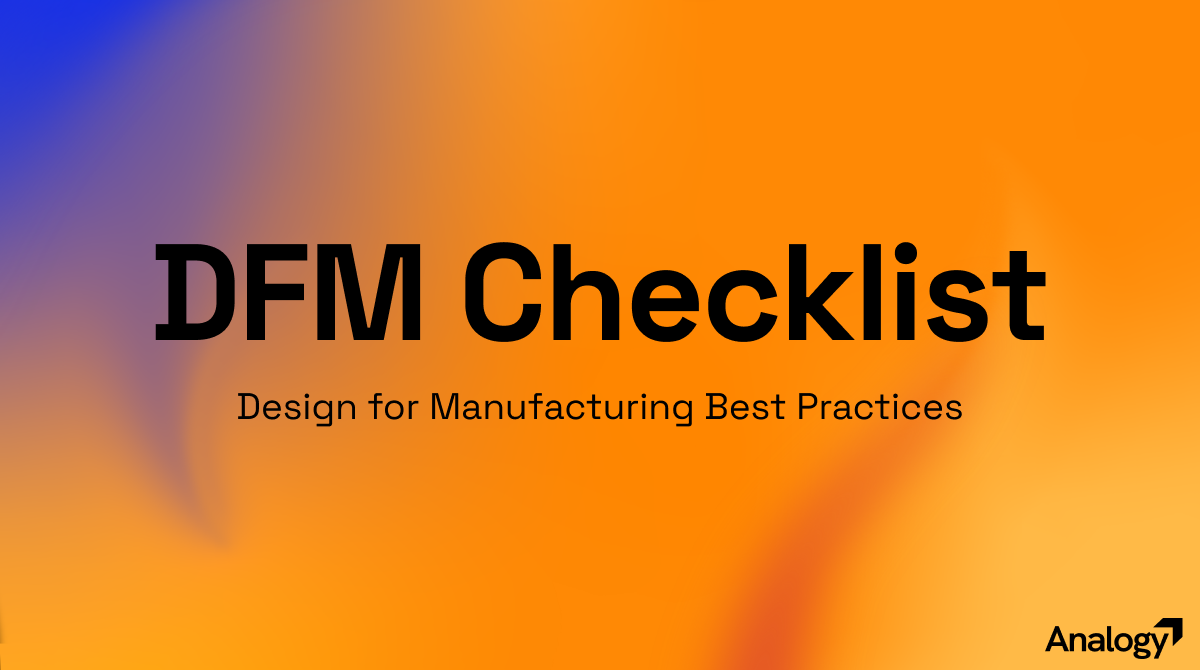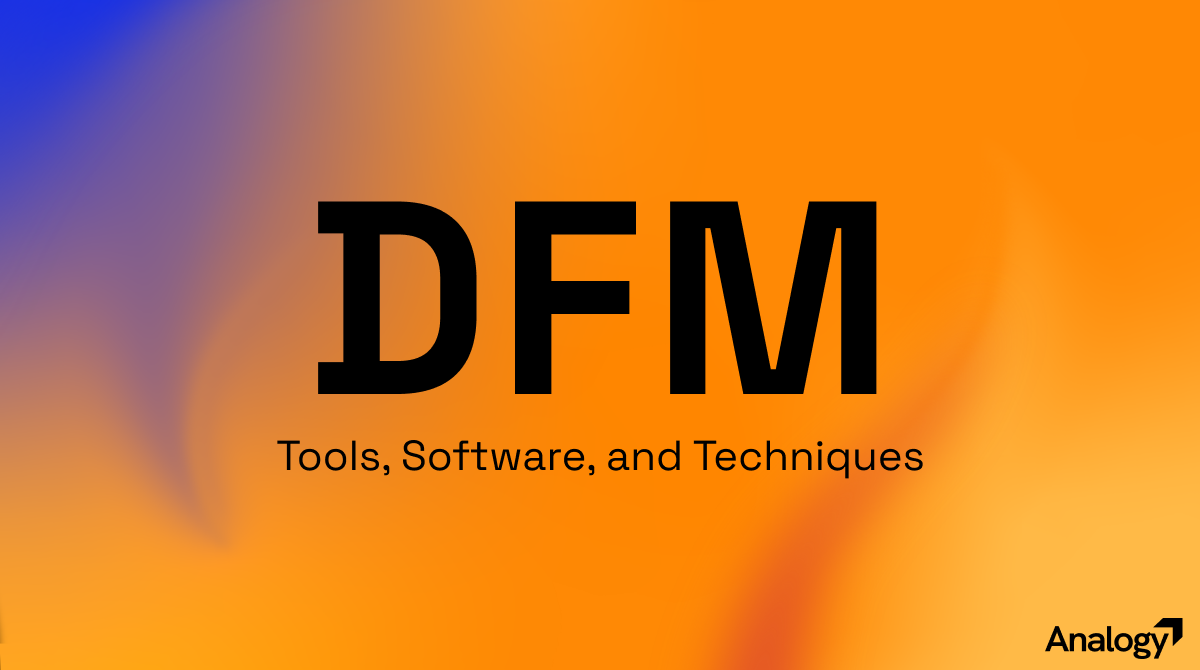
DFM Checklist: Design for Manufacturing Best Practices
This DFM Checklist is built for entrepreneurs, engineers, and product creators who want to save time, reduce costs, and avoid last-minute manufacturing nightmares. It covers every stage from concept and materials to tooling, assembly, and quality control. Brilliant ideas often fail not because they’re bad, but because they’re hard, or expensive, to manufacture. That’s where Design for Manufacturing (DFM) changes the game. DFM is the art of designing products that are easy, efficient, and cost-effective to produce, without compromising on quality or innovation.
This article is a part of the Design for Manufacturing (DFM) series:
- Design for Manufacturing (DFM) Complete Guide – Analogy
- DFM Glossary: 100 Commonly Used Terms In Design for Manufacturing
- DFM Examples: Real World Case Studies & Visual Gallery
- DFM Checklist: Design for Manufacturing Best Practices
- DFM Mistakes: 50 Common DFM Mistakes You Must Avoid
- DFM Tools: 50 DFM Tools, Software, and Techniques
Whether you’re building a hardware startup, a consumer product, or a complex mechanical assembly, a solid DFM approach ensures your design moves from CAD to production seamlessly.
Use it before you finalize your design, send files to manufacturers, or invest in tooling. Each checkpoint will help you:
- Identify design risks early
- Simplify parts and processes
- Cut unnecessary manufacturing costs
- Improve yield, reliability, and scalability
Think of this DFM checklist as your bridge between design brilliance and factory reality, helping you turn prototypes into production-ready products the smart way.
1. Product Definition
☐ Part Name – Confirm name matches design files.
☐ Part Number – Assign consistent numbering.
☐ Function – Clearly define the product’s purpose.
☐ Environment – Note operating conditions (temp, humidity, load).
☐ Regulations – Identify required standards (UL, CE, BIS, etc.).
☐ Production Volume – Estimate annual quantity.
☐ Target Cost – Set cost per unit and cost ceiling.
2. Material Selection
☐ Material Type – Choose material family (metal, polymer, composite).
☐ Material Grade – Specify exact grade and supplier.
☐ Availability – Check global/local supply and lead time.
☐ Process Compatibility – Ensure it suits chosen process.
☐ Mechanical Properties – Verify strength, hardness, elasticity.
☐ Thermal & Chemical Stability – Match environment needs.
☐ Sustainability – Prefer recyclable or renewable materials.
3. Part Design
☐ Geometry Simplification – Eliminate unnecessary shapes/features.
☐ Uniform Wall Thickness – Maintain consistency to avoid warpage.
☐ Draft Angles – Add draft for mold release or machining clearance.
☐ Fillets & Radii – Remove sharp corners to reduce stress.
☐ Ribs & Bosses – Reinforce instead of thick walls.
☐ Avoid Undercuts – Simplify for easier tooling.
☐ Feature Accessibility – Ensure machining or molding access.
☐ Tolerance Control – Use tight tolerances only where needed.
4. Manufacturing Process
☐ Process Choice – Select process suited to geometry & volume.
☐ Cycle Time Optimization – Reduce steps and material waste.
☐ Tooling Complexity – Keep mold or jig design simple.
☐ Secondary Operations – Minimize trimming, polishing, etc.
☐ Fixture Requirement – Confirm stability during machining/assembly.
☐ Standardization – Use off-the-shelf components or processes.
5. Assembly & Joining
☐ Part Count Reduction – Combine components where feasible.
☐ Fastener Choice – Use standard screws, nuts, or snaps.
☐ Assembly Direction – Prefer single-direction assembly (top-down).
☐ Self-Alignment – Design for automatic positioning or orientation.
☐ Tool Access – Allow screwdriver or welding gun clearance.
☐ Ease of Handling – Ensure ergonomic fit for operators.
☐ Serviceability – Enable disassembly for repair or recycling.
6. Tooling & Fixtures
☐ Tool Type – Define mold, die, or fixture type.
☐ Material & Hardness – Specify steel grade or tooling material.
☐ Ejection System – Define pins, sleeves, or air eject.
☐ Cavity & Core Balance – Verify even fill and cooling.
☐ Maintenance Access – Design for easy cleaning and service.
☐ Identification Marks – Engrave part name, number, and version.
7. Dimensional & Tolerance Design
☐ Critical Dimensions – Identify key functional dimensions.
☐ GD&T Application – Use geometric dimensioning for precision.
☐ Stack-Up Analysis – Evaluate tolerance accumulation.
☐ Process Capability – Match Cpk with tolerance bands.
☐ Inspection Points – Add features for QC measurement.
8. Electronics / PCB (If Applicable)
☐ Component Availability – Confirm no EOL or long-lead items.
☐ Thermal Design – Add heat sinks or airflow paths.
☐ Mounting & Clearance – Avoid interference with housing.
☐ Testing Access – Include test points and connectors.
☐ Shielding & Grounding – Ensure EMC/EMI compliance.
9. Quality & Testing
☐ Inspection Plan – Define critical-to-quality checks.
☐ First Article Test – Plan initial run validation.
☐ Defect Prevention – Design to avoid flash, sink, or deformation.
☐ Process Control – Define tolerances achievable by process.
☐ Field Reliability – Simulate real-world stresses and fatigue.
10. Cost & Supply Chain
☐ BOM Optimization – Identify high-cost items to redesign.
☐ Tooling Cost – Estimate mold/die fabrication and lifespan.
☐ Manufacturing Cost per Unit – Track process, labor, and waste.
☐ Packaging Efficiency – Design for compact and safe packing.
☐ Supplier Validation – Audit supplier capability and quality.
11. Sustainability & End-of-Life
☐ Material Recyclability – Prefer mono-material assemblies.
☐ Design for Disassembly – Use joints that can be separated easily.
☐ Waste Reduction – Optimize cutting or molding layouts.
☐ Energy Efficiency – Minimize energy-intensive steps.
☐ Labeling & Recycling Marks – Add proper disposal symbols.
12. Documentation & Review
☐ Version Control – Keep consistent revision management.
☐ DFM Review Record – Document each checkpoint status.
☐ Change Tracking – Log design and process updates.
☐ Production Readiness Approval – Sign-off before tooling.
☐ Feedback Loop – Record learnings from production and field use.
Why DFM Is The Smartest Step Before You Build
Design for Manufacturing isn’t just about lowering production costs, it’s about designing smarter, faster, and with real-world feasibility in mind. A well-executed DFM process saves time, reduces rework, and ensures that innovation survives the journey from prototype to product. Whether you’re refining a startup idea or scaling a global product line, this checklist helps you build with confidence, turning bold concepts into manufacturable, market-ready solutions.
Bookmark and save this DFM checklist for your future reference.
Sources
About The Author

Dinesh Krishnamoorthy – Lead Design Engineer, DFM Expert
Dinesh Krishnamoorthy is a Design for Manufacturing (DFM) specialist with 9 years of experience in product engineering and production optimization. He graduated with a B.E. in Mechanical Engineering from Dhanalakshmi Srinivasan Engineering College (Anna University), Perambalur, and began his career as a Quality Engineer. His passion for design led him to Butterfly Gandhimathi Appliances Ltd, where he gained hands-on experience in both product design and manufacturing. This exposure shaped his deep understanding of DFM principles, learning directly from mold designers and production teams. At Analogy, Dineshkumar integrates manufacturing considerations from the earliest design stages, ensuring efficient, cost-effective, and production-ready products. He believes DFM transforms CAD designs into real, launch-ready products, making the engineering process smoother and more impactful.
FAQs
news & insights
Continue reading

Design for Manufacturing (DFM) Complete Guide
DFM stands for “Design for Manufacturing” or “Design for Manufacturability”. Design for Manufacturing (DFM) is both a philosophy and a practice that bridges the gap between design intent and manufacturing reality.






